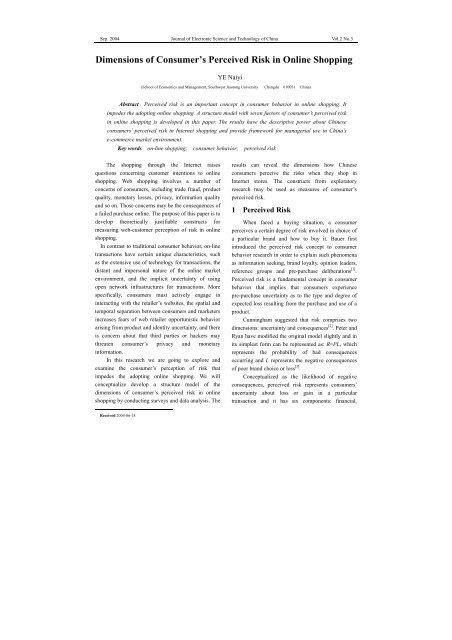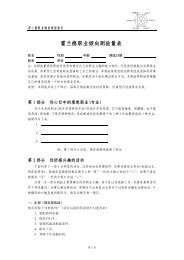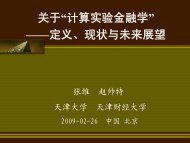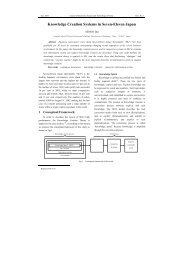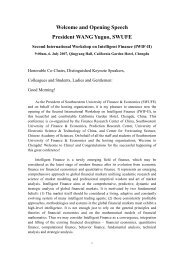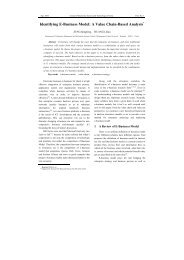Dimensions of Consumer's Perceived Risk in Online Shopping
Dimensions of Consumer's Perceived Risk in Online Shopping
Dimensions of Consumer's Perceived Risk in Online Shopping
Create successful ePaper yourself
Turn your PDF publications into a flip-book with our unique Google optimized e-Paper software.
No.3 YE Naiyi: <strong>Dimensions</strong> <strong>of</strong> Consumer’s <strong>Perceived</strong> <strong>Risk</strong> <strong>in</strong> Onl<strong>in</strong>e Shopp<strong>in</strong>g 179age, gender, and education background, experience <strong>of</strong>Internet use, experience <strong>of</strong> onl<strong>in</strong>e shopp<strong>in</strong>g, and<strong>in</strong>tentions to Internet shopp<strong>in</strong>g and where they comefrom, to get the demographic <strong>in</strong>formation.We take many class times to ask the students toscore the items <strong>in</strong> the questionnaire. The itemsrepresent the concerns <strong>of</strong> respondents may have <strong>in</strong> anonl<strong>in</strong>e shopp<strong>in</strong>g. In order to keep a generalization, wegave a scenario <strong>in</strong> which we did not specify the goodpurchased, but we set a scenario <strong>of</strong> a purchase with thevalue over 100 RMB Yuan <strong>in</strong> an Internet store <strong>in</strong> orderto make the onl<strong>in</strong>e buy<strong>in</strong>g action relatively important.After conduct<strong>in</strong>g the survey, the data wascollected, coded and exam<strong>in</strong>ed. We f<strong>in</strong>ally obta<strong>in</strong>ed336 effective questionnaires as our analyz<strong>in</strong>g cases.Then, we use SPSS 11.5 to conduct exploratory factoranalysis (EFA) to obta<strong>in</strong> the assumed factor structure,and use LISREL 8.54 to conduct confirmatory factor(CFA) analysis to test the validation <strong>of</strong> the model.4 Data Analysis and DiscussionsFirstly, we exam<strong>in</strong>ed the reliability <strong>of</strong> the wholedata by conduct<strong>in</strong>g reliability analysis and obta<strong>in</strong>ed theCronbach α <strong>of</strong> 0.913. S<strong>in</strong>ce the α coefficient isrelatively high, then data collected and themeasurement are considered reliable. Than we haveobta<strong>in</strong>ed the demographic <strong>in</strong>formation <strong>of</strong> the allrespondent. The results <strong>of</strong> their demographiccharacteristics are shown <strong>in</strong> Tab.1.Tab.1Demographic statistics <strong>of</strong> respondentDemographic statisticsSexMale: 195, 57.7%Female: 143, 42.3%EducationUndergraduate Student: 188, 55.6%Graduate Student: 150, 44.4%AgeRange: 18 ~ 45Average: 24.54ShopperHave experience <strong>of</strong> shopp<strong>in</strong>g onl<strong>in</strong>e: 57, 16.9%Have no experience <strong>of</strong> shopp<strong>in</strong>g onl<strong>in</strong>e: 281, 83.1%Attitude to Shopp<strong>in</strong>g Onl<strong>in</strong>ePositive: 283, 83.7%Negative: 54, 16.3%After that, we conducted explanatory factoranalysis to f<strong>in</strong>d the dimensions <strong>of</strong> onl<strong>in</strong>e consumer’sperceived risk. We performed pr<strong>in</strong>ciple componentanalysis and used the orthogonal rotation method <strong>of</strong>Varimax with Kaiser Normalization that m<strong>in</strong>imizes thenumber <strong>of</strong> variables that have high load<strong>in</strong>gs on eachfactor. We obta<strong>in</strong>ed the rotated factor load<strong>in</strong>gs as <strong>in</strong> theTab.2. It presents the factor analysis <strong>of</strong> the PRD. Thefactor solution expla<strong>in</strong>s 63.291% <strong>of</strong> the variation. Theeigenvalues <strong>of</strong> all factors exceed 1.0. We have thefollow<strong>in</strong>g explanations about those seven factors.Tab.2 Cronbach α <strong>of</strong> seven factors from EFAFactors from EFAαFactor 1: e-Store source risk 0.799 0Factor 2: Delivery risk 0.839 9Factor 3: F<strong>in</strong>ancial risk 0.752 6Factor 4: Product performance risk 0.680 3Factor 5: Shopp<strong>in</strong>g Process risk 0.679 3Factor 6: Privacy risk 0.628 2Factor 7: Asymmetric <strong>in</strong>formation risk 0.633 4Factor 1: fraud risk. This factor measures aconsumer’s concerns about seller’s reliability <strong>in</strong> onl<strong>in</strong>eshopp<strong>in</strong>g. Items load<strong>in</strong>g on this factor measure an<strong>in</strong>dividual’s concern to the opportunistic behavior <strong>of</strong>the onl<strong>in</strong>e retailer. It <strong>in</strong>cludes seller’s reliability andpost-services and so on. The highest load<strong>in</strong>g <strong>of</strong> theitem T1 measures the perception to the web store’sfraud behavior.Factor 2: delivery risk. This factor measures aconsumer’s concern about product delivery. It coversthe concerns about the loss and damage <strong>of</strong> product, andwrong dest<strong>in</strong>ation <strong>of</strong> delivery. The highest load<strong>in</strong>gmeasures a consumer’s concern about the loss <strong>of</strong>onl<strong>in</strong>e purchased product.Factor 3: f<strong>in</strong>ancial risk. This factor measures aconsumer’s concern about monetary loss whenshopp<strong>in</strong>g through the Internet. It relates to lowerdiscount <strong>in</strong> onl<strong>in</strong>e shopp<strong>in</strong>g compar<strong>in</strong>g to traditionalshopp<strong>in</strong>g and extra charges <strong>of</strong> delivery and onl<strong>in</strong>epayment.Factor 4: process and time loss risk. This factormeasures the easy and convenience <strong>of</strong> a consumer’sperception about Internet shopp<strong>in</strong>g. The highestload<strong>in</strong>g <strong>of</strong> the item PS1 measures a consumer’sperceived complexity and <strong>in</strong>convenience exceed<strong>in</strong>g theexpected process <strong>of</strong> onl<strong>in</strong>e shopp<strong>in</strong>g.Factor 5: product risk. This factor measures a
180Journal <strong>of</strong> Electronic Science and Technology <strong>of</strong> Ch<strong>in</strong>a Vol.2consumer’s concern about the product quality,performance, falseness <strong>of</strong> a product, and productrelated problem. The highest load<strong>in</strong>g measures aconsumer’s perceived quality.Factor 6: privacy risk. This factor measures aconsumer’s concern about the security <strong>of</strong> personal<strong>in</strong>formation. It <strong>in</strong>cludes a consumer’s home address,telephone number, e-mail address, and account number<strong>of</strong> credit or debit cards. The highest load<strong>in</strong>g <strong>of</strong> the itemmeasures a consumer’s concern about the misuse <strong>of</strong>home address and telephone number.Factor 7: <strong>in</strong>formation risk. This factor measures aconsumer’s perception <strong>of</strong> asymmetric <strong>in</strong>formationabout both <strong>of</strong> sellers and products. The highest load<strong>in</strong>g<strong>of</strong> the item measures the concern <strong>of</strong> a consumer aboutthe lack <strong>of</strong> <strong>in</strong>formation about sellers.Tab.3Factor load<strong>in</strong>gs <strong>of</strong> EFA and coefficients <strong>of</strong> determ<strong>in</strong>ation <strong>of</strong> CFAFactors and Underly<strong>in</strong>g itemsLoad<strong>in</strong>gs(EFA)StandardizedCoefficients <strong>of</strong>Determ<strong>in</strong>ation(CFA)T(CFA)R 2(CFA)Fraud <strong>Risk</strong>T1: Onl<strong>in</strong>e <strong>in</strong>formation about product is not true. 0.784 0.577 10.813 0.333T2: It is difficult to get support when product fails. 0.716 0.647 12.464 0.419T3: Can’t f<strong>in</strong>d the place where to settle disputes. 0.669 0.735 14.737 0.540T4: Web store could disappear after runn<strong>in</strong>g bus<strong>in</strong>ess <strong>in</strong> short time. 0.585 0.585 10.987 0.342T5: Fail to keep the promise <strong>of</strong> post-services. 0.559 0.764 15.526 0.583Delivery <strong>Risk</strong>D1: The delivered product could be lost. 0.798 0.811 16.861 0.658D2: Delivered the product to a wrong place. 0.774 0.794 16.379 0.631D3: The product is damaged dur<strong>in</strong>g the deliver<strong>in</strong>g. 0.751 0.789 16.229 0.622F<strong>in</strong>ancial <strong>Risk</strong>F1: Traditional stores <strong>of</strong>fer more discount than onl<strong>in</strong>e store. 0.755 0.450 8.019 0.203F2: Onl<strong>in</strong>e stores <strong>of</strong>fer discount price but the total cost is not lower. 0.673 0.638 12.081 0.407F3: Onl<strong>in</strong>e payment will charge extra fees. 0.642 0.780 15.678 0.609F4: Deliver<strong>in</strong>g to the home will charge relatively higher fees. 0.572 0.761 15.177 0.580Process and Time Loss <strong>Risk</strong>PS1: The process <strong>of</strong> onl<strong>in</strong>e shopp<strong>in</strong>g is complex and <strong>in</strong>convenient. 0.788 0.519 8.838 0.296PS2: To deal with PC for access<strong>in</strong>g Internet will take too much time. 0.687 0.721 12.636 0.514PS3: Information transformation is too slow dur<strong>in</strong>g onl<strong>in</strong>e shopp<strong>in</strong>g. 0.668 0.710 12.497 0.504Product <strong>Risk</strong>PT1: The quality <strong>of</strong> the product is not accepted. 0.797 0.583 10.120 0.340PT2: The product performance is not consistent with the expectation. 0.659 0.620 10.858 0.385PT3: The product may be false and the quality will be poor. 0.567 0.500 8.497 0.250PT4: It is difficult to return when the product is not satisfied. 0.553 0.651 11.473 0.424Privacy <strong>Risk</strong>PY1: Worry<strong>in</strong>g about that the personal address, telephone numbercould be misused by others.0.727 0.583 10.088 0.340PY2: My e-mail address could be misused by others. 0.718 0.795 13.716 0.632PY3: The account number <strong>of</strong> my credit or debit card could bemisused by others.Information <strong>Risk</strong>IN2: The <strong>in</strong>formation about onl<strong>in</strong>e suppliers is not sufficient.0.591 0.454 7.666 0.2070.809 0.715 10.365 0.497IN1: The <strong>in</strong>formation about product to be purchased is not sufficient. 0.788 0.658 9.901 0.432
No.3 YE Naiyi: <strong>Dimensions</strong> <strong>of</strong> Consumer’s <strong>Perceived</strong> <strong>Risk</strong> <strong>in</strong> Onl<strong>in</strong>e Shopp<strong>in</strong>g 181The presented seven factors structure model hasthe descriptive power about the dimensions <strong>of</strong>consumer’s perceived risk <strong>in</strong> onl<strong>in</strong>e shopp<strong>in</strong>g. Themodel consists <strong>of</strong> seven factors extracted from selected24 variables. The Cronbach α coefficient for the 24variables is 0.881 9. That provides the evidence for thereliability <strong>of</strong> the items measuresEach factor keeps also a relatively higherCronbach α coefficient (for attitude survey) for themodel. Tab.2 lists the Cronbach α coefficients for theseven factor structure model.To exam<strong>in</strong>e the validities <strong>of</strong> the developedconstructs <strong>of</strong> the model, we also used the results fromthe EFA to conduct confirmatory factor analysis. Weobta<strong>in</strong>ed the Coefficients <strong>of</strong> Confirmation from CFA.The results are shown <strong>in</strong> the Tab.3.The purpose CFA is to exam<strong>in</strong>e the validity <strong>of</strong> themodel. We used the results <strong>of</strong> the EFA as ourhypnotized model to confirm the validity <strong>of</strong> the itemmeasures. We use 24 variables as measures and sevenfactors as latent variables to build a hypothesizedmeasurement model. Then we set the variance <strong>of</strong> eachl<strong>in</strong>ear equation to 1 to get the complete standardizedestimations <strong>of</strong> the model. We obta<strong>in</strong>ed standardizedcoefficient estimations and R 2 as listed <strong>in</strong> the Tab.3.The CFA results show that all coefficients aresignificant to represent the l<strong>in</strong>ear relationship betweenvariables and the related factors. Some R 2 values areacceptable and some <strong>of</strong> them are relatively low, thatrepresents that those measures still need to improve.CFA is basically <strong>in</strong>volved specification <strong>of</strong> ahypothesized model and confirm whether this model isconfirmed by the underly<strong>in</strong>g data.CFA is basically <strong>in</strong>volved specification <strong>of</strong> ahypothesized model and confirm whether this model isconfirmed by the underly<strong>in</strong>g data. The better themeasures <strong>of</strong> fit, the more accurate the data <strong>in</strong> relationto the proposed theory. Accord<strong>in</strong>g to recommendations<strong>of</strong> some researchers (Hair et al., 1998), X 2 should notbe significant, X 2 /df is recommend between 1.0~2.0,GFI is better closed to 1, AGFI is recommend morethan 0.8, RMSR is recommend closed to 0; RMSEA isalso recommend closed to 0, NFI is recommend morethan 0.9, CFI is better closed to 1 [12] .Tab.4 lists the results <strong>of</strong> the goodness <strong>of</strong> fit fromconfirmatory factor analysis. All <strong>in</strong>dexes <strong>of</strong> goodness<strong>of</strong> fit are acceptable except the X 2 -test. The X 2 -test washighly significant at p=0.00. However, X 2 -tests aresample size dependent and favor complex models thansimple ones. When it is adjusted for degrees <strong>of</strong>freedom, these and other measures <strong>of</strong> fit areacceptable.Tab.4 Goodness <strong>of</strong> fitGoodness <strong>of</strong> fitX 2 430.601(P = 0.00)X 2 /df 1.864Goodness <strong>of</strong> Fit Index (GFI) 0.907Adjusted Goodness <strong>of</strong> Fit Index (AGFI) 0.879Root Mean Square Residual (RMSR) 0.143Root Mean Square Error <strong>of</strong> Approximation(RMSEA)0.049Comparative Fit Index (CFI) 0.969df: Degrees <strong>of</strong> Freedom (= 231)5 ImplicationsAlthough the primary purpose <strong>of</strong> this researchwas to substantiate electronic commerce theory, somemanagerial implications both for e-commerceresearchers and managers can be derived from theresult<strong>in</strong>g research work. Firstly, the research drawsattention to consumer’s perception <strong>of</strong> risk <strong>in</strong> Internetshopp<strong>in</strong>g. Some researches focused on the consumer’s<strong>in</strong>tentions to buy through retailer’s web site, but failedto identify the consumer’s perceived risk <strong>in</strong> onl<strong>in</strong>eshopp<strong>in</strong>g (George Banabanis and Stefanos Vassileiou,1999) [13] . This research may raise the <strong>in</strong>terests <strong>in</strong>consumer’s perceived risk about onl<strong>in</strong>e shopp<strong>in</strong>g andmotivate managers take account <strong>in</strong>to consumer’sconcern when make e-commerce strategies.<strong>Perceived</strong> risk can be used as overall factor toexpla<strong>in</strong> the risk perception and risk deduction strategyused by consumers. Because outcomes <strong>of</strong> an exchangeare uncerta<strong>in</strong>, consumers desire to reduce their risk <strong>in</strong>purchas<strong>in</strong>g. The dimensions <strong>of</strong> perceived riskdeveloped <strong>in</strong> this research are provided for managerswhen they design their e-commerce strategies to satisfythe consumer’s risk reduction need.
182Journal <strong>of</strong> Electronic Science and Technology <strong>of</strong> Ch<strong>in</strong>a Vol.2Our research has developed a structure model formeasur<strong>in</strong>g consumer’s perceived risk <strong>in</strong> onl<strong>in</strong>eshopp<strong>in</strong>g. The 24 variables are identified as measures<strong>of</strong> consumer’s perceived risk. In the structure model,we f<strong>in</strong>d out seven factors as dimensions <strong>of</strong> theconsumer’s perceived risk <strong>in</strong> Ch<strong>in</strong>a’s Internet shopp<strong>in</strong>gcontext. The factor one is e-store source risk, factortwo is delivery risk; the factor three is f<strong>in</strong>ancial risk;the factor four is purchas<strong>in</strong>g process and time loss risk;the factor five is product performance risk; the factorsix is privacy risk; and the factor seven is asymmetric<strong>in</strong>formation risk.Research draws attention to consumer’sperception <strong>of</strong> risk <strong>in</strong> Internet shopp<strong>in</strong>g and providesthe specifications about the dimensions <strong>of</strong> Ch<strong>in</strong>eseconsumer’s preserved risk <strong>in</strong> the onl<strong>in</strong>e context. It maymotivate managers take account <strong>in</strong>to consumer’sconcern and provide more chances for managers to useour f<strong>in</strong>d<strong>in</strong>gs for their managerial practice <strong>in</strong> ane-commerce market environment.AcknowledgementThis paper is supported by the National NaturalScience Foundation <strong>of</strong> Ch<strong>in</strong>a.References[1] Bauer R A. Consumer Behavior as <strong>Risk</strong> Tak<strong>in</strong>g. In D.F.Cox (ed.), <strong>Risk</strong> Tak<strong>in</strong>g and Information Handl<strong>in</strong>g <strong>in</strong>Consumer Behavior[M]. Cambridge: Harvard UniversityPress, 1960. 389-398[2] Cunn<strong>in</strong>gham S M. The Major <strong>Dimensions</strong> <strong>of</strong> <strong>Perceived</strong><strong>Risk</strong>. <strong>in</strong> Cox, D.F. (Ed.), <strong>Risk</strong> Tak<strong>in</strong>g and InformationHandl<strong>in</strong>g <strong>in</strong> Consumer Behavior[M]. Boston GraduateSchool <strong>of</strong> Bus<strong>in</strong>ess Adm<strong>in</strong>istration, Harvard UniversityPress, 1967. 82-108[3] Peter J P, Rayan N J. An <strong>in</strong>vestigation <strong>of</strong> perceived risk atthe brand level[J]. Journal <strong>of</strong> Market<strong>in</strong>g Research, 1976,13:184-188[4] Kaplan L B, Jacoby J, Szybillo G. Components <strong>of</strong>perceived risk <strong>in</strong> product purchase: a cross-validation[J].Journal <strong>of</strong> Applied Psychology, 1974, 59(3): 287-291[5] Fram E H, Grady D B. Internet shoppers: is there a surfergender gap[J]. Direct Market<strong>in</strong>g, 1997,59 (9): 46-50[6] Jarvenpaa S L, Todd P A. Consumer reactions to electronicshopp<strong>in</strong>g on the world wide web[J]. International Journal<strong>of</strong> Electronic Commerce, 1996, 1(2): 59-88[7] Nyshadham E A. Privacy policies <strong>of</strong> air travel web sites: asurvey and analysis[J]. Journal Air Transport Management,2000, 6: 143-152[8] McCorkle D E. The role <strong>of</strong> perceived risk <strong>in</strong> mail order–catalog shopp<strong>in</strong>g[J]. Journal <strong>of</strong> Direct Market<strong>in</strong>g, 1990, (4):26-35[9] Engel J F, Blackwell R D. <strong>Perceived</strong> risk <strong>in</strong> mail-order andretail store buy<strong>in</strong>g[J]. Journal <strong>of</strong> Market<strong>in</strong>g Research, 1970,7: 364-369[10] Nena L. Consumers’ perceived risk: sources versusconsequences[J]. Electronic Commerce Research andApplications, 2003, 2: 216-228[11] Sandra M, Shi F B. Consumer patronage and riskperceptions <strong>in</strong> Internet shopp<strong>in</strong>g[J]. Journal <strong>of</strong> Bus<strong>in</strong>essResearch, 2003, 56(11): 867[12] Hair J F, Anderson R E, Tathan R L, et al. MultivariateData Analysis[M]. EngleWood Cliffs, NJ: Prentice Hall,1998[13] Banabanis G, Vassileiou S. Some attitud<strong>in</strong>al predictors <strong>of</strong>home shopp<strong>in</strong>g through the Internet[J]. Journal <strong>of</strong>Market<strong>in</strong>g Management, 1999, (15): 361-385Brief Introduction to Author(s)YE Naiyi is an associate pr<strong>of</strong>essor <strong>in</strong> School <strong>of</strong> Economicsand Management, Southwest Jiaotong University, Ch<strong>in</strong>a. Hiscurrent research <strong>in</strong>terests <strong>in</strong>clude: electronic commerce,market<strong>in</strong>g, consumer behavior.


